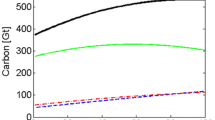Abstract
The impact of managing biomass specifically for the conservation or production of energy can become a significant factor in the global management of atmopsheric CO2 over the next century. This paper evaluates the global potential for: (1) conserving energy by using trees and wood for shading, shelterbelts, windbreaks, and construction material; and (2) increasing the use of biomass and improving its conversion efficiency for producing heat, electricity, and liquid biofuels. The potential reduction in CO2 emissions possible by the anticipated time of atmospheric CO2 doubling was estimated to be up to 50×106t C yr−1 for energy conservation and as high as 4×109 t C yr−1 for energy production. Of the many opportunities, two stand out. Through afforestation of degraded and deforested lands, biomass energy production offers the potential of 0.36 to 1.9×109t C yr−1 emission reduction. Dedicated energy crops, which include short-rotation woody crops, herbaceous energy crops, halophytes, some annual crops, and oilseeds, offer the potential of 0.2 to 1.0×109t C yr−1 emission reduction. Also addressed in the paper, but not quantified, were establishment of new forests, increasing the productivity of existing forests, or protecting forests to sequester C as an offset against CO2 emissions from burning fossil fuels or forest destruction. Also addressed are uncertainties, gaps in scientific knowledge about ecosystems and their management, and policy considerations at the international and national levels.
Similar content being viewed by others
References
Betters, D. Wright, L.L., and Couto, L.: 1992, Short Rotation Woody Crop Plantations in Brazil and the United States,Biomass and Bioenergy 1(6), 305–316.
Brandle, J.R., Wardle, T.D., and Bratton, G.F.: 1992, Opportunities to Increase Tree Planting in Shelterbelts and the Potential Impacts on Storage and Conservation, in Sampson, R.N. and Hair, D., eds.,Forests and Global Change, Volume 1: Opportunities for Increasing Forest Cover, Washington, DC:American Forests, pp. 157–176.
Burschel, P., Kürsten, E., and Larson, B.C.: 1993, Die Rolle von Wald und Forstwirtschaft im Kohlenstoffhaushalt — Eine Betrachtung für die Bundesrepublik Deutschland, Forstl. Forschungsberichte München, Nr. 126, (short version in English).
Dixon, R.K., Andrasko, K.J., Sussman, F.A., Trexler, M.C. and Vinson, T.S.: 1993, this volume.
Farnum, P., Timmis, R. and Kulp, J.L.: 1983, Biotechnology of Forest Yield,Science 219, 694–702.
Glenn, E.P., Pitelka, L.F. and Olsen, M.W.: 1993, this volume.
Graham, R.L., Wright, L.L., and Turhollow, A.: 1992, The Potential for Short Rotation Woody Crops to Reduce CO2 Emissions,Climatic Change 22, 223–238.
Gregersen, H., Draper, S., and Elz, D.: 1989, People and Trees: The Role of Social Forestry in Sustainable Development, Washington, DC: World Bank, 273 pp.
Hall, D.O., 1991, Biomass Energy,Energy Policy 19(8), 711–737.
Hall, D.O., Rosillo-Calle, F., Williams, R.H., and Woods, J.: 1993, Biomass for Energy Supply Prospects, in: Johansson, T.B., Kelly, H., Reddy, A.K.N., and Williams, R.H., eds.,Renewable Energy, Washington, DC: Island Press.
Houghton, J.T., Callander, B.A. and Varney, S.K. (eds): 1992,Climatic Change 1992 — the Supplementary Report to the IPCC Scientific Assessment, Intergovernmental Panel on Climate Change, Report prepared for IPCC by Working Group I, New York: Cambridge University Press.
Keim, C.R. and Venkatasubramanian, K.: 1989, Economics of Current Biotechnological Methods of Producing Ethanol,Trends in Biotech,7, 22–29.
Kinsman, J.D. and Trexler, M.C.: 1993, this volume.
Kürsten, E. and Burschel, P.: 1993, this volume.
Marland, G. and Marland, S.: 1992, Should We Store Carbon in Trees,Water, Air & Soil Pollution,64, 181–196.
Marland, G. and Turhollow, A.F.: 1991, CO2 Emissions from the Production and Combustion of Fuel Ethanol from Cora,Energy 16, 1307–1316.
Nilsson, L. and Wiklund, K.: 1992, Influence of Nutrient and Water Stress on Norway Spruce Production in South Sweden — The Role of Air Pollutants,Plant and Soil 147, 251–265.
Sampson, R.N., Moll, G.A., and Kielbaso, J.J.: 1992, Opportunities to Increase Urban Forests and the Potential Impacts on Storage and Conservation, in: Sampson, R.N. and Hair, D., eds.,Forests and Global Change, Volume 1: Opportunities for Increasing Forest Cover, Washington DC: American Forestsz, pp. 51–72.
Sampson, R.N.: 1981,Farmland or Wasteland: A Time to Choose, Emmaus, PA: Rodale Press. 465 pp.
Scurlock, J.M.O. and Hall, D.O.: 1990, The Contribution of Biomass to Global Energy Use (1987),Biomass 21, 75–81.
Sedjo, R.A. and Lyon, K.S.: 1990,The Long-Term Adequacy of World Timber Supply, Resources for the Future, Washingtonm, DC: John Hopkins University Press, pp. 30–31.
Trexler, M.C.: 1993, this volume.
Trexler, M.C. and Haugen, C.A.: 1993 forthcoming, Keeping it Green: Global Warming Mitigation Through Tropical Forestry, Washington, DC: World Resources Institute.
U.S. Environmental Protection Agency: 1992.Cooling our Communities: A Guidebook on Tree Planting and Light-Colored Surfacing, 22P-2001, Washington, D.C.
US Environmental Protection Agency: 1993,Forests for the Future: Launching Initial Partnerships, Report of an Interagency Task Force, January 15.
Winjum, J.K., Dixon, R.K., and Schroeder, P.E.: 1992, Estimating the Global Potential of Forest and Agroforest Management Practices to Sequester Carbon,Water, Air & Soil Pollution 64, 213–227.
WRI: 1992,World Resources 1992–1993, World Resource Institute, New York: Oxford University Press, 383 pp.
Wright, L.L. and Hughes, E.: 1993, this volume.
Wright, L.L., Graham, R.L., Turhollow, A.F. and English, B.C.: 1992, The Potential Impacts of Short-Rotation Woody Crops on Carbon Conservation, in: Sampson, R.N. and Hair, D., eds.,Forests and Global Change, Volume 1: Opportunities for Increasing Forest Cover, Washington DC: American Forests, pp. 123–156.
Author information
Authors and Affiliations
Rights and permissions
About this article
Cite this article
Sampson, R.N., Wright, L.L., Winjum, J.K. et al. Biomass management and energy. Water Air Soil Pollut 70, 139–159 (1993). https://doi.org/10.1007/BF01104993
Issue Date:
DOI: https://doi.org/10.1007/BF01104993




